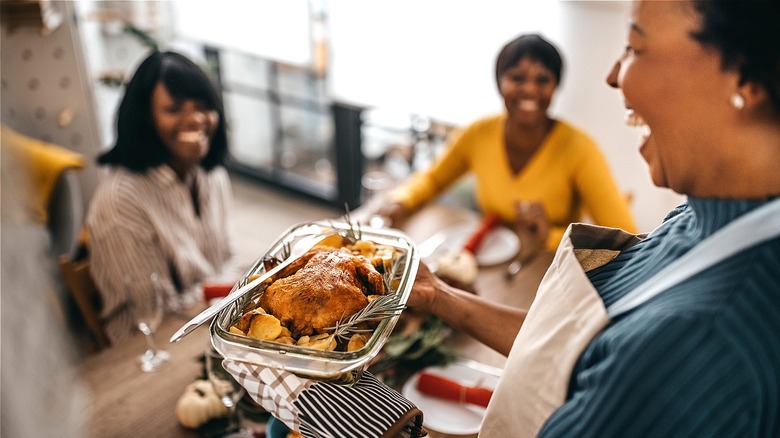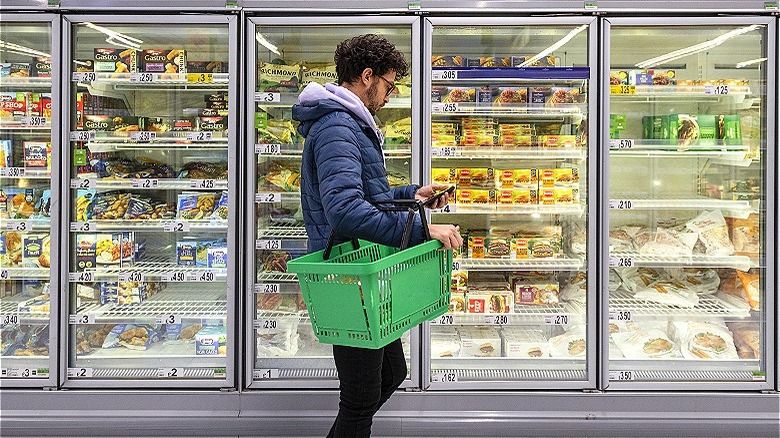Here's How Much More You'll Be Paying For Thanksgiving Dinner This Year
As if the holidays weren't stressful enough, did you know that current economic factors can have a huge effect on your turkey dinner this year? While most of us are glad to see the price of things like milk and eggs has come down in recent months, these staples aren't enough to offset the rest of the table trimmings. In addition to the fact that grocery prices have risen nearly 17% in the past two years, the Consumer Price Index has found that food categories, specifically, are up 3.3% over last year. When compared to 2022 prices, this year's Thanksgiving Day meal is set to cost you 14% more, according to the University of Tennessee Extension.
A significant factor in this price increase has to do with the record-breaking retail spreads occurring across the country. Despite wholesale prices dropping on key Thanksgiving ingredients like turkey and ham, many retailers are keeping prices high. This is not only costing consumers more this holiday season, but it is also pushing ingredients like ham to all-time highs in terms of pricing (according to the Wells Fargo 2023 Thanksgiving Consumer Report, retail ham prices are 5.2% higher than last year).
With this in mind, it's also important to realize how both inflation and its sneakier cousin, shrinkflation, can and will affect your Thanksgiving shopping this year. Let's dive into how both factors might make you second-guess just how big your Thanksgiving meal should be.
Inflation and Thanksgiving
It's no secret that prices are up across the board, and at this point, we're all pretty tired of hearing (and reading) about it. Inflation has been a near-constant battle since the pandemic and most consumers know to expect higher prices, especially at the grocery store. According to the National Restaurant Association, between (pre-pandemic) February 2020 and October 2023, grocery store prices were up by 25%.
It can be difficult for consumers, though, to actually experience fluctuations in inflation given company strategies and retail markups that cloud overall pricing changes. While inflation has slowed down since 2022, it's still absolutely affecting prices and wallets. Thanksgiving side dishes, in particular, are expected to cost 4% more in 2023, with canned green beans costing 9% more and russet potatoes at an all-time high average price of $1.17 per pound. Also, pumpkin pie lovers might be in for quite a shock with canned pumpkin prices currently 30% higher than last year.
With the increase in prices, it's no wonder that more and more Americans are choosing to skip the hassle and headache of making their own Thanksgiving dinner altogether. According to a 2023 survey from Popmenu, which provides restaurants with digital marketing and ordering technology, 32% of consumers plan to order takeout/delivery for Thanksgiving dinner, while 17% plan to eat at a restaurant. However, according to the National Restaurant Association, menu prices rose 5.4% since October 2022. This means that while you might be saving yourself the hassle of shopping (and the dreaded dishes) you won't necessarily be saving money by dining out this Thanksgiving.
Shrinkflation and Thanksgiving
One of the reasons it can be difficult to calculate the exact rate of inflation that might be affecting you this holiday season is due to a tactic known as shrinkflation. Rather than raising prices and scaring off potential customers, some companies use a strategy known as shrinkflation in which they lessen the amount of a product consumers get for the same price. For example, say your favorite cornbread stuffing box is usually $4.99 for 10 ounces, a company will keep the same price point but will now only provide 6 ounces per box. This makes it harder to get a true measurement of inflation because prices have technically stayed the same, even though consumers must spend more.
While it might be hard to calculate the inflation rate, the takeaway for consumers is the same: Your money won't get you as much as it did before. Smaller package sizes can lead to higher spending, especially for holiday meals like Thanksgiving that are generally for larger groups (LendingTree found that Americans expect 11 guests, on average). Less stuffing per box means consumers will have to buy more boxes, thereby raising the overall price of their holiday meal.
It is also worth mentioning that many of the popular canned goods and sides that are currently experiencing higher-than-average prices are also items that are easily affected by shrinkflation. Ann Berry, professor and consumer economics specialist at the University of Tennessee Extension, who led the team whose study found that this year's Thanksgiving Day meal will cost 14% more, advised consumers when it comes to shrinkflation, "Remember to check your recipes and adjust for any discrepancies."


